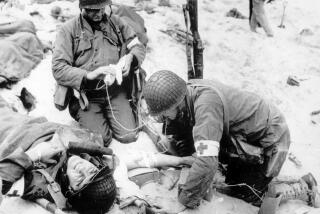Diagnosis in the heat of battle
“The Unit,” episode: “Five Brothers,” Nov. 6, CBS, 9 p.m.
The premise: The unit’s rangers are in Beirut. As they rescue a kidnapped journalist from Hezbollah terrorists, ranger Charles Grey (Michael Irby) is shot. The rescue chopper crashes. Team leader Jonas Blane (Dennis Haysbert) and marksman-medic Hector Williams (Demore Barnes) are compelled to commandeer a family’s apartment and perform emergency surgery on Grey, who is losing a lot of blood, coughing and having trouble breathing.
Although Williams doesn’t have a stethoscope, he states that Grey has a collapsed lung. He lays Grey on the family’s dining room table and inserts an intravenous line, placing the bag of solution under the man’s head for pressure. He makes an incision in Grey’s chest without administering a painkiller, widens it and inserts a chest tube. As Williams tells Grey to breathe deeply, bloody fluid drains from his lung into the tube, down into a jar of water. There is a slight hissing as the chest lung reinflates and Grey breathes more easily.
But he is losing a lot of blood and his heart rate is increasing. Blane thinks Grey is OK because his chest is not distended and there are no discolorations, but Williams believes a second bullet must be responsible for the continued bleeding. He turns Grey on his stomach and finds the entrance wound. Fearing that the sharp bullet has severed an artery and could do more damage, Williams reaches into the wound with his finger, locates the bullet and pulls it out. He then clamps the artery with a surgical clamp.
Medical questions: Can a medic diagnose that a wounded soldier has a collapsed lung without benefit of a stethoscope? Do field kits not contain painkillers, stethoscopes, sterile gloves, antiseptic or forceps? Shouldn’t the IV bag be hung from a lamp or door rather than put under the soldier’s head? Once a chest tube is inserted, is it possible to have the patient breathe in order to reinflate the lung, with gravity causing bloody drainage to siphon down into a pitcher of water?
Is Blane correct that the lack of chest distention or discoloration is a good sign, or is Williams right that the rapid heart rate and apparent continued blood loss is the sign of a second bullet? Would a field medic reach into a wound to remove a bullet and then blindly clamp an artery?
The reality: The clinical diagnosis of a “dropped lung” can be made without a stethoscope, by observing distended veins in the neck, difficulty breathing and absence of the movement of breathing on one side of the chest, says Cmdr. D. J. Green, an assistant professor of trauma surgery at Keck School of Medicine of USC and Naval Trauma Training Center. The description of the chest tube insertion and lung re-expansion are likewise accurate, he says.
“The patient breathes, the lung expands, the blood/air are expelled through the tube as a one-way valve,” Green says. But, he points out, field kits routinely include the painkiller lidocaine, sterile gloves, the antiseptic Betadine, forceps and stethoscopes. He says hanging the IV bag from 4 feet above the patient would provide a much better infusion rate of fluid.
The continued rapid heart rate and probable associated blood loss wouldn’t necessarily imply a second gunshot wound, Green says, adding that Grey could still be bleeding from the first wound. And Dr. H. Leon Pachter, chief of surgery at New York University School of Medicine and former trauma chief at Bellevue Hospital Center, adds that the lack of discoloration and chest distention doesn’t mean the first wound is doing well.
As for the handling of that second bullet, Pachter says: “Pulling out a bullet or any penetrating object is counter to accepted trauma principles, as the penetrating object may be tamponading [putting pressure on] the injury. With its extraction, massive bleeding could ensue.” In any case, this bullet seems to be too superficial to be causing massive bleeding. The finger method and blind clamp, according to Pachter are “right out of H.G. Wells.”
--
Dr. Marc Siegel is an internist and an associate professor of medicine at New York University’s School of Medicine. He is also the author of “False Alarm: The Truth About the Epidemic of Fear.” In The Unreal World, he explains the medical facts behind the media fiction. He can be reached at marc@doctor siegel.com.
More to Read
The complete guide to home viewing
Get Screen Gab for everything about the TV shows and streaming movies everyone’s talking about.
You may occasionally receive promotional content from the Los Angeles Times.






